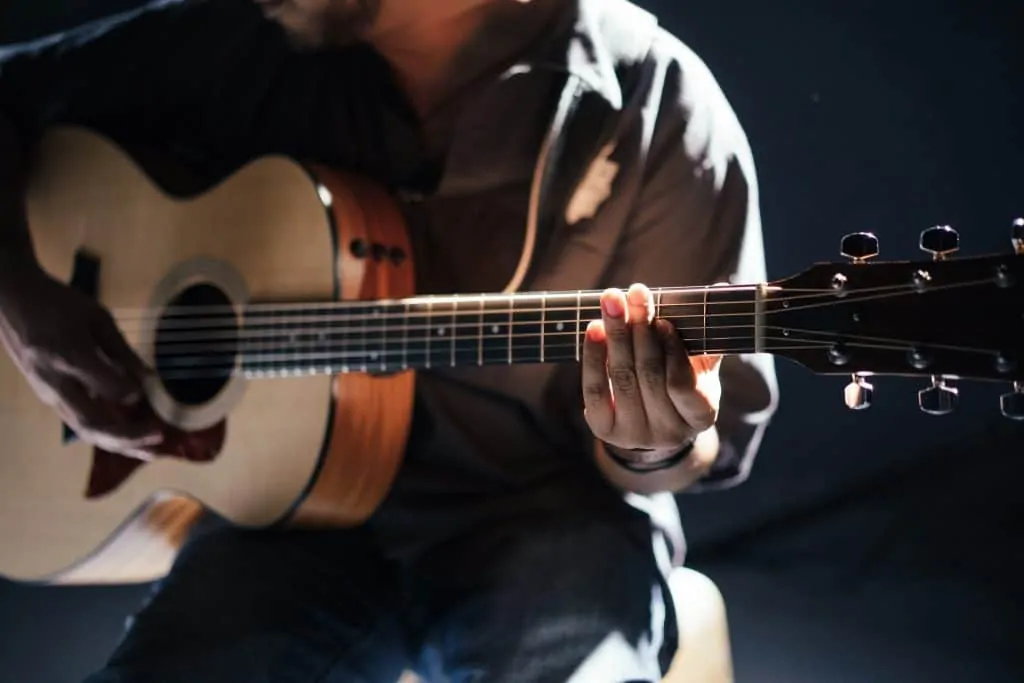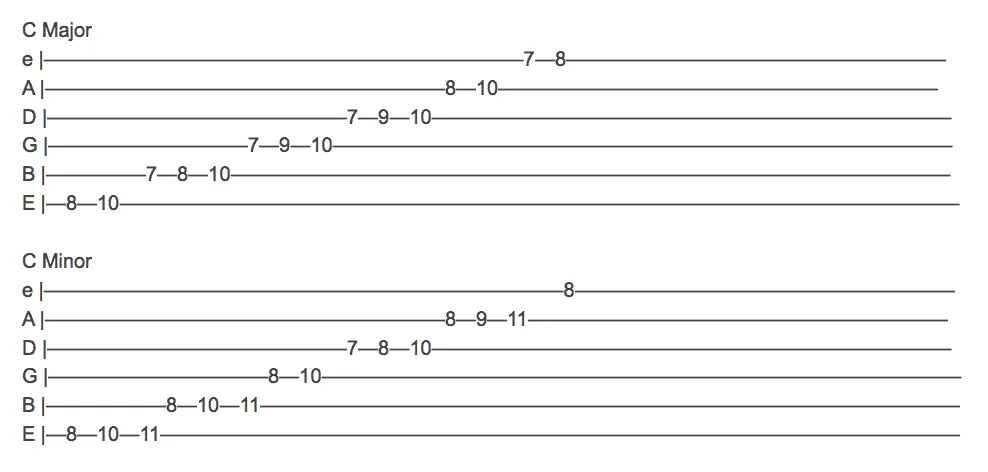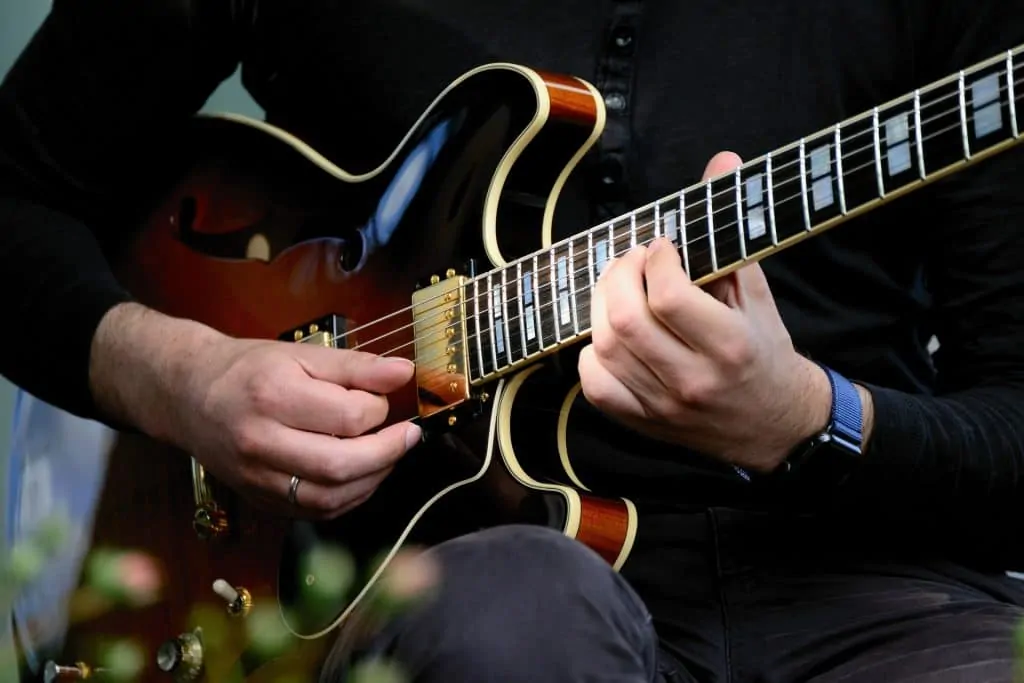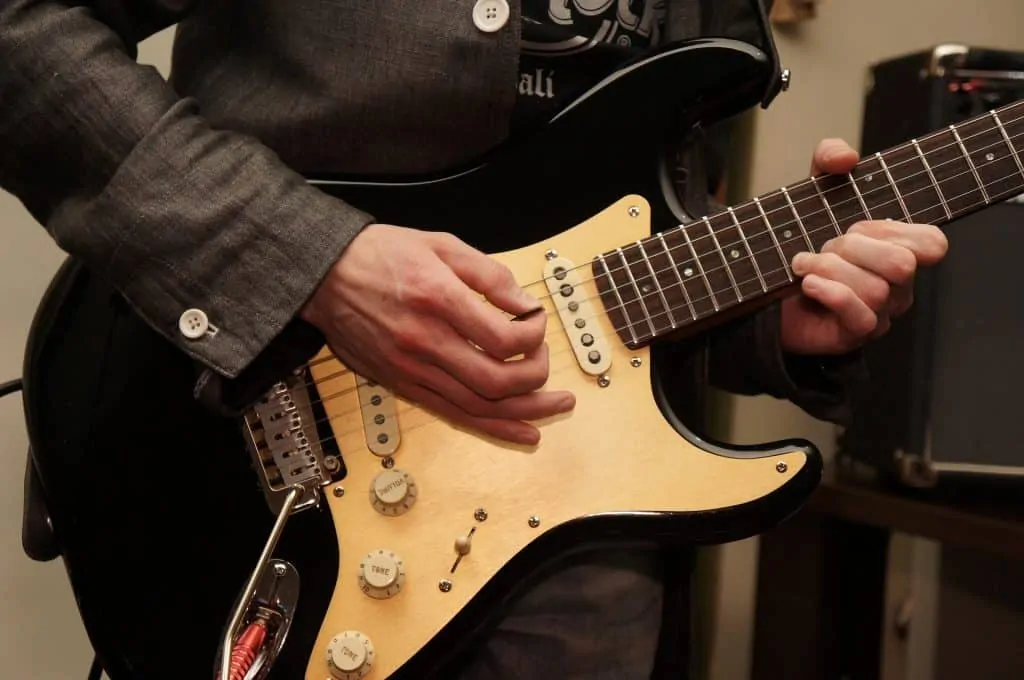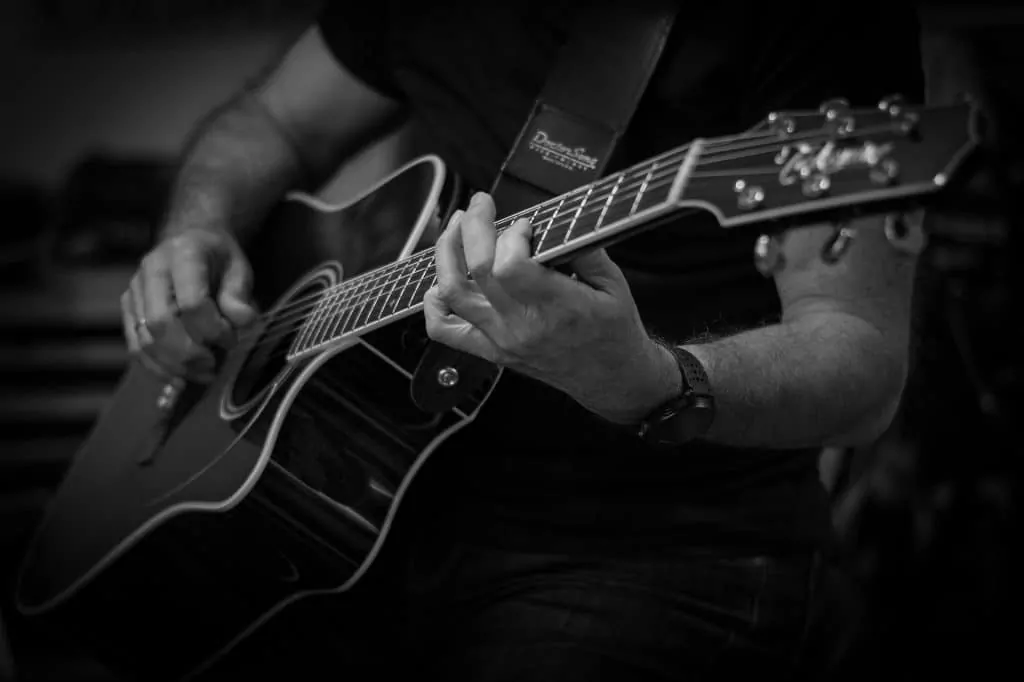Structured, diligent practice is essential to improve your guitar skills over time.
Everyone first picks up the guitar for a different reason. Many of us just wanted to play our favorite song. Others wanted to emulate a certain guitar hero. Regardless of the motive, most beginners start out by learning to play the most basic chord shapes and working on novice songs.
Every new player quickly learns that they won’t be able to immediately play rock-solid rhythm and solo effortlessly; the road to advanced playing can take years and even decades. Unfortunately, many beginners don’t know how to structure a dedicated practice routine to achieve those long-term goals.
Without a plan, far too many players devolve into aimless noodling and an inconsistent and ineffective practice schedule. To truly progress on the guitar and develop into a proficient player, you’ll need to outline and follow a detailed regimen to improve all facets of your playing.
Focus and concentration are the most important things to bring to each practice session.
Contents
Focusing Your Practice
The first and most crucial step to developing a guitar practice routine is simply to focus your practice. This has more to do with mindset than with actual drills — it’s possible to practice for 15 minutes and have more focus than someone who plays for four hours.
The key to focus is building a deliberate mindset around the guitar and your practice routine. Rather than just deciding to play whenever you feel like it, try to carve out a daily time for you to practice. If you can’t dedicate one set time each day of the week, find pockets of free time you can use to play.
Before starting your practice each day, make a brief mental note of your plans for the day’s practice. What aspects of your playing do you want to improve? What new concepts do you want to work on? What songs do you want to play? Taking even 30 seconds at the beginning of your routine to flesh out answers to these questions will vastly improve your effectiveness.
As you practice, stay locked in on the guitar and the songs you’re playing. To whatever extent possible, stay off of Netflix and social media while you practice; it’s far better to practice for 30 minutes without distractions than to play around aimlessly for two hours while really focusing on a TV show.
This approach doesn’t mean you need to take all the fun out of playing guitar — the instrument should always be a source of enjoyment first and foremost, rather than a chore. However, to improve over time you’ll need to practice even when “playing guitar” isn’t the first thing on your free time priority list and treat the instrument with focus whenever you do play. The time and effort you invest into improving on the instrument will pay dividends as you progress.
Always keep your practice materials organized in a dedicated space.
Organizing Your Practice Space
One often overlooked component of any practice routine is the space you practice in itself. Treat your practice space the same way you approach your playing: keep everything focused, and try to eliminate potential distractions wherever you can.
Whether you practice in your bedroom, living room, kitchen, or in front of the TV, the most important aspect of your practice space is the chair you play on. Make sure this seat has no armrests or cushions that can impede your arm movement as you play. Maintain solid posture while playing; try to avoid kicking your legs up or leaning far back and resting the guitar on your stomach.
Next to your guitar and amp, you should have some space to put your computer and sheet music. Make sure it’s easily accessible from your playing position, and that you can read the sheet or screen clearly from where you sit to play. This is the perfect spot for you to transcribe songs, play through chord charts, or read tabs.
Keep plenty of accessories, like a capo, tuner, pick, stand, case, cable, and strap handy in your practice space. Having everything nearby will help you stay in the flow of your practice and prevent annoying searches across the carpet when you inevitably drop your pick.
Outlets are always a good idea to have in your practice space, especially if you want to jam with friends. Make sure you have enough to plug in your amp and your pedalboard; one or two extra spaces couldn’t hurt as well.
A mirror can also be a great tool to examine your own playing in real time. While full-length mirrors can be a bit extreme unless you already have one laying around, a desktop mirror is a cheap and portable investment to improve your playing.
Tilt it to show your hands on the guitar, especially your strumming hand. Oftentimes the easiest way to diagnose technique flaws is to see them from a third-person perspective; looking at the mirror as you play will help you both notice and correct any problems.
Practice Space Essentials
- Chair without armrests (encourage good posture)
- Space to display songs and sheet music
- Mirror to identify technique issues
- Open outlet space
Working on your scales will help you grasp more complex chords with ease, like this D9 chord.
Scales & Theory
Scales and theory may be the most boring part of any guitar practice routine, so it’s best to get them out of the way first. In all seriousness, though the material may be dry, it’s essential for any player to have a solid grasp of scales and basic music theory. Knowing fundamental patterns and which chords they sound good over will help you immensely when you begin improvising solos.
Contrary to popular belief, scale work doesn’t have to take up a majority of your practice. The exact number may fluctuate depending on how many scales you know and which ones you’re learning, but scale work should generally occupy around 20 percent of your total practice time.
When you practice your scales, practice each scale for two octaves through the circle of fifths, beginning with G (fifth string, third fret) and ending at C (sixth string, eighth fret). Playing the full circle of fifths for each scale forces you to learn a scale form in all twelve keys and find ways to play notes across the entire fretboard. For a more detailed primer on the circle of fifths and how it relates to guitar, check out this video.
C Major and C Minor two-octave scale forms from the eighth fret root.
Which Scales to Practice
The first scale any guitar player should learn is the major scale. As the foundation for nearly all of music theory, the major scale is incredibly important to know backwards and forwards.
The major scale is formed from a pattern of whole and half steps, from a root note up to the same root note one octave higher. To make any major scale, you’ll just need to follow this pattern: whole step, whole step, half step, whole step, whole step, whole step, half step.
After learning the major scale, you should next focus on the natural minor scale. Sometimes referred to as the Aeolian mode (the sixth mode of the major scale), natural minor scales correspond with standard minor chords and are some of the most popular and useful chords around. Once again, you should play the minor scale through two octaves in all 12 keys.
The natural minor scale is closely related to the minor pentatonic scale, the primary scale used throughout much of rock and blues music. In turn, the addition of the blue note (the flatted fifth scale degree) transforms the minor pentatonic scale into the blues scale. Practicing the minor pentatonic scale is essential for any rock or blues player. As a bonus, it’s an easy scale to shred.
C Major and C Minor Pentatonic two-octave scales from the eighth fret root.
Modes
Once you’ve got the major, minor, and minor pentatonic scales under your belt, you can begin learning different modes. Each mode is a different scale pattern created to lend a different feel to chords and solos. In order, the seven modes are Ionian (major), Dorian, Phrygian, Lydian, Mixolydian, Aeolian (natural minor), and Locrian.
Though the modes of the major scale use the same exact notes as the major scale itself, they change the tension by moving the start and end of the scale. Rather than centering on the key of a passage, in other words, modes emphasize the tonality and sound of a certain chord (corresponding to their order in the scale).
Using different modes over each chord in a progression can help break you out of the pentatonic scale “box” and spice up your improvisation beyond simple major scale work.
Modes of the major scale are essential to learn as you move beyond standard blues-based soloing into more complex forms. Genres like jazz, prog rock, and psychedelic rock tend to prefer modes to more common major and minor progressions.
Knowing when to substitute modes for simple major and minor scales in the same key — for example, Dorian and Mixolydian over classic rock progressions or Phrygian in jazz and classical tunes — will open up a new world of tones for your soloing.
Arpeggios and interval training are especially helpful for creating improvisation ideas high up the guitar neck.
Arpeggios and Intervals
Beyond your modes and the major and minor pentatonic scale, you should also practice a few key arpeggios and some interval training. While these may come in handy when soloing, they also have the added benefit of developing finger strength and dexterity. Working on these each day at the end of your scale routine will speed up your playing and increase your precision.
The best arpeggios to practice through the circle of fifths are “seventh” arpeggios, so named because they contain the seventh note of the scale in addition to the root, third, and fifth. There are different flavors, each depending on the different intervals between the root, third, and seventh.
The three seventh arpeggio scale forms in C Major, from the eighth fret root.
The major 7th, minor 7th, and dominant 7th arpeggios are the most essential arpeggios — these will help you improvise over major and minor chord progressions, especially the II – V – I progressions that are so ubiquitous in styles like jazz.
If you’d like to practice more, work with the basic root-third-fifth arpeggios. You can add on the diminished and half-diminished arpeggios as well for some extra color.
The last chunk of your ideal scale routine should be interval training. The most common intervals to begin with are thirds and fifths. To play the major scale in thirds, simply play the first note then play the note up a (major) third interval, play the second note of the scale and then move up a third interval from there, and so on. It’s the same pattern with fifths, fourths, sixes, sevenths, and any other intervals you can think of.
If you want to finish off with a test of your speed and precision, try playing the major scale in a unique way: play up one octave from the root, then go back down to the second note of the scale and play up an octave from there. Continue until you’ve reached the top, then go back down in the same fashion.
Proper scale practice requires a consistent routine.
How to Practice Scales Properly
Because the scales, arpeggios, and intervals presented above can easily seem daunting, it’s especially important to break the regimen down properly.
Playing all the modes, pentatonic scales, arpeggios, and intervals through the entire circle of fifths is the ideal scale warmup. Once you feel comfortable fingering each scale pattern without stopping, the exercises may take up to 15 or 20 minutes at the most. But before you’ve got everything memorized cold, the process is much slower going.
Many beginner players choose to break the entire package up while learning it bit by bit. Rather than spending 15 minutes fumbling around with every imaginable scale, they focus on perfecting one before moving on to the next pattern. In the long run, this approach will pay dividends as you’ll retain the information better and be able to utilize it more effectively on the fly.
Even if you’re still learning, play more than one scale a day and add to your workload as you become more proficient. You’ll find that pretty soon you’re flying through the scales you once struggled to grasp.
A sample practice routine for a newer learner might look something like this: play the major, minor, and major and minor pentatonic scales as a warm up before every practice session. Depending on the day of the week, add one of the other five modes, or practice the three core arpeggios and some interval training. Mapping out your plan like this and sticking to it will increase both your knowledge and enjoyment of the guitar over the long term.
Practicing Scales Alone
If you don’t have quite enough time to start a full practice routine, shedding scales while you relax is a fantastic way to reinforce your muscle memory and integrate the scales into your playing. In fact, the Grateful Dead’s Jerry Garcia developed his master grasp of chords and major melody by playing scales for multiple hours at a time while he was watching TV.
Though you shouldn’t multitask your way through your whole practice routine, it’s possible to still work on your scale technique and reinforce the proper patterns while, for example, watching something else. As long as you pay attention to your technique and take care not to fall into bad habits, the extra practice time will benefit your precision, speed, and dexterity.
Practicing songs is the best way to increase your knowledge of different chords.
Practicing Songs
Once you’ve finished with scales, it’s time to move onto something more interesting: practicing songs. Though it may seem easier or less structured than the more rigid scales and arpeggio practice, working on songs you enjoy is a crucial part of developing your personal style as a guitar player.
To select the songs you play, look first to what music you love to listen to. What motivated you to play guitar in the first place? While you may not be able to begin practicing Van Halen songs immediately, working on songs you enjoy listening to will make your practice a lot more entertaining and offer you concrete measurements of your progress as you improve.
To begin learning a new song, you’ll need to listen to it first. Make sure you can remember the melody and have an idea of the general song structure before you practice it; doing the legwork beforehand will help you avoid confusion as you play and protect you from creating bad habits like playing the melody slightly off or mistaking the chords in the bridge.
Beginners can start learning a song by finding the chords online. If you’re a more advanced player you may be able to quickly pick up the chords by ear, though finding a chord sheet online can’t hurt to confirm your intuition. Begin playing the chords along with the song, trying to find the most comfortable voicing on the fretboard for each chord.
To work on songs accurately, you’ll need a solid grasp of different chord voicings around the neck. The CAGED system is a great primer, but depending on the genre you may also need to know more complex extended chords or different voicings. Check out our series on how to play and apply different chords for a more in-depth look.
Online covers or lessons can be helpful when you’re learning, especially to get a better feel for the rhythm and for certain chord voicings. As you gain more experience working out new songs, you may eventually be able to create arrangements without needing a full lesson. Live videos of the artist playing may be hard to decipher, but can also provide the most accurate interpretation of a given track.
After you have a feel for the song, put on the original record and try to play along. Rhythm should be your main goal, but as you feel more comfortable you can incorporate more of the melody and lead lines into your arrangement.
Truly practicing songs is distinct from just knowing the main riff, or being able to roughly hammer out the chords. It’s easy to fall into a rut with your song practice, or to treat a song as “completed” when you only know parts of it. Remember to stay focused and work on each song until you truly know it — you should be able to play each song you know along with the record and in a live setting without problems.
Practicing songs should take up anywhere from 25 to 30 percent of your total practice time. Catalogue every song you know as you learn it, and make sure to run through a balanced selection each time you practice songs. If you don’t remember or ever practice many of the songs you learned at one point, you’re far more liable to forget them and be forced to start over.
Strategies for Practicing Songs
- Focus on chords and structure before lead work
- Emphasize the melody in your arrangement
- Learn the whole song, not just the riff
Listening to complex solos and breaking them down by ear will strengthen your skills for improvisation, jamming, and live gigs.
Ear Training
As you progress on the guitar, you’ll need to develop your ears. While we’re lucky enough to live in an age where tabs, chords, and lessons are all available online, many of our guitar heroes were forced to learn records by ear: famous players from George Harrison, Eric Clapton, and Jimi Hendrix to Eddie Van Halen and Slash all could not read music and had to learn their favorite songs simply by listening to them over and over until they picked up the notes.
To be sure, tabs and chords are valuable resources, and there’s no need to abandon them completely. However, developing well-tuned ears will help you beyond just learning how to play your favorite solos. Good ear training is fundamental for songwriting, live playing, and jam sessions.
The most effective way to develop good ears is practice: specifically, transcribing solos and songs. If you’ve never tried to transcribe by ear before, begin with a simple song or solo. Avoid songs that feature lots of double stops and chordal solos, as the multiple notes make it more difficult to transcribe accurately. File them away and come back to them later as you improve your skills.
Blues songs are fantastic for beginner transcribers because the solos all fall within the same scale. Once you know the minor pentatonic scale, hearing the different notes and transcribing them from your ear is much easier. Familiarity with the blues scale will also help you “see” how the notes fit together on the fretboard as the solo develops.
Whenever you run into trouble as you’re transcribing, try to hum the notes you’re hearing and then play different notes on the fretboard until you find the pitch. As your ears develop, this will get easier to do and eventually become second nature. Remember that slides, bends, and hammer-ons and pull-offs can alter the character of a given note; take care to add these articulations as you work for a more accurate final transcription.
After blues songs, try transcribing slightly more complex cuts. This may entail working on much faster songs, where the notes are harder to distinguish, or songs outside of the traditional pentatonic box, where you’ll have to identify and visualize which scales the guitarist is playing in as you go.
Another important element to remember is fingering. Unlike piano, violin, or most other traditional instruments, guitarists can play the same note in multiple locations on the fretboard. This can complicate any transcription process, especially if you end up with a final product that’s incredibly difficult to play. Check your work to see how you might play it as you go, and try to find the best location on the fretboard for the simplest fingerings.
Don’t get discouraged if you struggle to transcribe a certain song or line. If you can’t pick it up by ear alone, finding a live video of the artist playing their song may help you visualize the fretboard and the crack the parts you’re having trouble with. If that still doesn’t help, file the song away and return to it after some more practice transcribing simpler passages. Oftentimes the additional experience is all you may need to transcribe the more difficult lines.
Spend about 25 percent of your total practice session working on transcribing and training your ears. Note that this time may also overlap with the time you spend practicing new songs — if you’re playing a song with an interesting or unique solo, you might transcribe that by ear after learning the chords to the rest of the tune.
Song Transcription Essentials
- Identify the song’s key and scale
- Remember to add articulations
- Hum the notes if you struggle
Fluid improvisation is a necessary skill for any guitarist, whether you’re in a band, doing session work, or playing solo gigs.
Improvisation
Smooth, effortless improvisation is the hallmark of a great guitarist. It’s also one of the most daunting skills for newer players to master. While it may seem out of reach, with a strong foundation in scale work and transcription you can prepare yourself to improvise fluidly.
The minor pentatonic scale is the first and most important scale the majority of players learn to improvise in. The foundation of blues and most rock and roll, the minor pentatonic scale also turns up in genres like jazz and modern music. Simply put, knowing the minor pentatonic scale cold puts you halfway to professional-level improvisation.
However, simple knowledge of the scale and the ability to play up and down very fast doesn’t make a great improviser. In the rush to create faster and more complex solos, many players simply play the scale in fast runs with a bend or slide tossed in occasionally. This is scale work, not soloing. Melodic, coherent improvisation requires greater knowledge and skill.
To build that knowledge, you should listen to and transcribe as many solos as possible, preferably ones in the same genre or that use the same scale. If you’re looking to improvise over a 12-bar blues, for example, transcribe solos by B.B. King, Eric Clapton, and Stevie Ray Vaughan. Look at and analyze the licks they use to build their solos, then apply their licks to your own solos rather than just playing chromatic or diatonic intervals up and down the scale.
Soloing over chord progressions harnesses different scales, modes, and arpeggios.
Soloing Over Chord Progressions
The 12-bar blues, one of the most basic stock chord progressions in modern music, is simple enough to improvise over; the minor pentatonic works over all three chords and provides ample room for experimentation throughout the form. As you progress, however, you’ll begin to play songs that require different scales over different chords.
There are plenty of different strategies for determining which scales to use over non-blues chord progressions. While the pentatonic scale of the home key will nearly always work well, there are more melodic, creative ways to solo as well.
In jazz and other more adventurous styles, players often select a different scale to solo over each chord. It takes a lot of practice to know and successfully move between different scales as chords change, particularly when playing faster songs.
Newer improvisers can determine which scale to use over which chord by examining the chord tones — that is, the notes that make up each chord they play. The chord tones will sound particularly good in your improvisation over that chord, and highlighting the chord tones for each chord great way to create melodic “movement” as you solo your way through the progression.
You should pick scales that will highlight the unique features of the chord you’re soloing over and distinguish it from the rest of the progression. For example, the flat seventh note in the Lydian dominant scale makes it sound great over dominant seventh chords, which also incorporate a flat seventh note.
Besides the pentatonic scale, the Mixolydian mode is one of the most common scales used for rock and blues improvisation. Harmonic minor and the Dorian mode are similarly common for songs in minor keys.
If you’re looking for some more directed tips on improvising, you should also check out our guide on how to improvise for beginners.
Tips to Solo Over Chord Progressions
- Begin with basic blues progressions where you can solo with one scale
- Find the chord tones to know which scales to use
- Highlight the unique sounds of each chord with your scales
Consistent improvisation practice with jamming is the best way to sharpen your skills.
Practicing Improvisation
Actually practicing improvisation is difficult without some sort of accompaniment; it’s very easy to lose track of the form or play dissonant notes when soloing over air.
If you don’t already have one, a looper pedal is a great investment for your practice. Simply play the chord progression you’d like to solo over, then loop it and improvise to your heart’s content. If you don’t own a looper or want a full band sound, you can search online for backing tracks (sometimes called jam tracks) to your preferred tunes.
When you sit down to solo, make a note of one specific lick or technique you want to incorporate in your improvisation that day. For example, it could be playing triplet riffs over a blues, or integrating dominant seventh arpeggios over a jazz II-V-I progression. On a bigger level, you might simply want to emphasize a certain scale, or a technique like sliding, bending, or hammering on to notes.
Don’t play forever without any structure. Once you sense you’re repeating yourself and struggling to add any new ideas, pause for a minute, analyze your results, and think of new ideas before you improvise again. With that being said, you should aim to stretch yourself out each time you practice improvising.
If you can only play one lick before you run out of ideas, try to solo for a full chorus before pausing (even if you just have to play the chord tones or diatonic intervals). If you can nail one chorus consistently, aim for two or three before you take a break.
Recording your soloing can be a very helpful tool to analyze your style and sharpen your skills. Hearing yourself on video can help you spot flaws in your technique or time feel. On a more important level, though, you’ll also be able to see how you build each solo and where you can improve.
Great guitarists build their solos over time. By creating (and ultimately releasing) tension, they can keep an audience locked in over long and complex instrumental passages. Beginner guitarists, by comparison, tend to play random licks they know with little semblance of order or organization.
When practicing your improvisation, try to develop your solos, building them up to a final climax. This means it’s probably a bad idea to play as fast as you can in the first chorus, or jump to bending the highest available note on the fretboard after just a couple bars. Take your time and gradually up the ante until you bring your solo to a stunning finish.
Improvisation practice should take around 25 percent of your regular routine. Oftentimes, you may choose to improvise some solos over a new tune you just learned, or re-imagine a different solo you transcribed earlier in your practice. It’s fine to blend the two parts together as long as you remain focused and apply the proper strategies to improve your playing.
Improvisation Practice Tips
- Stretch yourself out when soloing
- Build tension in your solos over time
- Emphasize one technique you want to improve each time
While practicing more will help you improve faster, it may still take you years to reach the levels of players like U2’s The Edge!
How Much Time Should I Practice?
There’s no magic bullet to guitar success, but consistent practice is about as close as you can get. While it’s hard to give a clear-cut answer, since every player practices and plays differently, you should strive to follow a few basic guidelines when evaluating how much you should practice.
First, try to practice as many days as possible. Maybe you take one day off a week, or one day off a year. What matters is that you’re consistently working on the guitar and reinforcing your muscle memory. A couple weeks without playing is all it takes to wipe out months of diligent practice for beginner players. In the struggle to re-learn and re-train their fingers to play, many beginners simply drop out and quit playing entirely.
Your practice time may also vary from session to session. Thirty minutes to an hour of practice daily will help most players make significant gains. More than an hour each day is even better, though many people may struggle to find the free time. Many professionals practice for two, three, or four-plus hours each day. If you’ve got the stamina and playing remains enjoyable, go for it!
It’s better to play in your free time than shoehorn in practice when you have no time; you’ll most likely just feel rushed and won’t have the mental energy to truly focus on your playing anyways. Whenever you do play, stick to the general practice routine breakdown above.
Spending 15-20 percent of your practice time on scales, 30 percent on learning new songs, 30 percent on transcribing new solos, and 20-25 percent on improvisation work will train all the important aspects of your playing over time.
Practice Time Breakdown
- Scales, arpeggios & intervals: 15-20 percent
- Learning new songs: 30 percent
- Transcribing new solos: 30 percent
- Improvisation: 20-25 percent
When it comes to practice, consistency and dedication are the keys to improvement.
Summary
Practice is the foundation of your guitar playing. Focused, guided practice can make a fantastic player, while aimless and lazy “practice” will lead to frustration and hamper any progress you may make on the instrument.
Each player is different, and no two players will practice exactly the same way. With that being said, however, breaking down your practice into four main blocks — scales and arpeggios, learning new songs, transcribing solos by ear, and improvising — will develop all different facets of your playing and help you improve in any genre.

